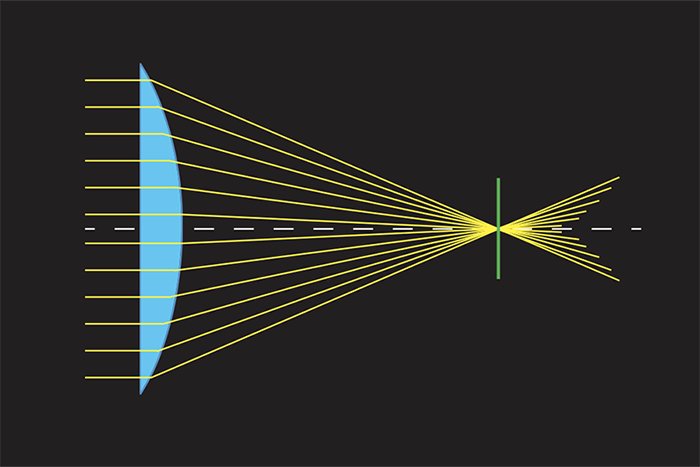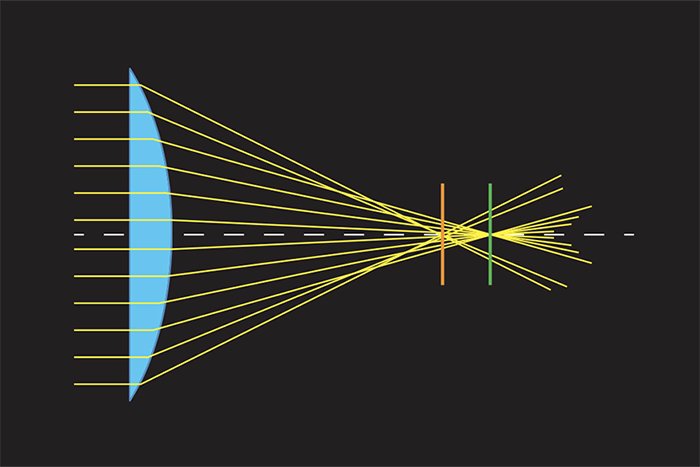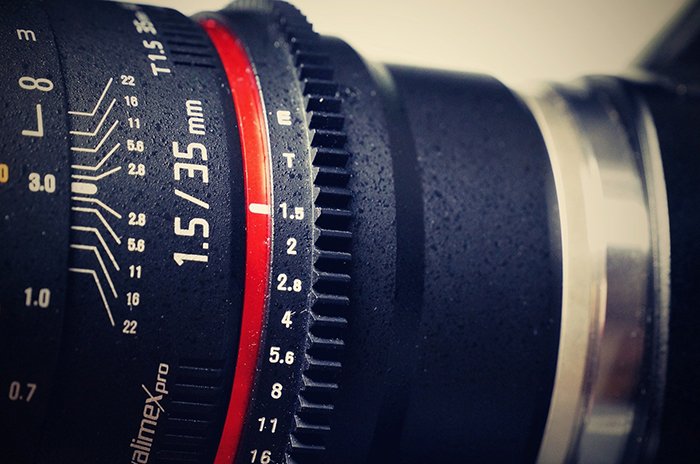We’ll see in this article what spherical aberration is and how you can get rid of it.
What Is Spherical Aberration?
The light that hits a spherical lens is refracted. In a perfect world, all the light rays should converge in what is called a focal point. If a lens had no flaws, there would be only one focal point and images would be sharp to the edges. Now, the problem is that the light that hits the edges of a spherical lens gets refracted at a different angle compared to the light that hits the center. As a result, those rays will converge in a different, non-optimal focal point. You can recognize spherical aberration when your photos get blurry towards the edges. Here’s a visual representation of spherical aberration. In this image, the green line is the optimal focal point, and all the light rays converge in that point. That’s where the sensor should also be.
And here, you can see that the rays of light hitting the edge of the lens converge in a different focal point (the orange line). The more different angles and focal points, the worse a camera lens suffers from spherical aberration. In this case, the focal point is in front of the sensor. The light doesn’t reach the sensor to create a sharp image.
How to Deal With Spherical Aberration?
First of all, spherical aberration doesn’t necessarily have to be a problem. If you’re shooting a portrait and your subject is in the center of the photo, it doesn’t matter if the edges are blurry. Usually, they will be blurry anyway because of the depth of field. Now, if you shoot landscapes and want your photos sharp to the edges, it could be a problem.
Stop Down
Usually, spherical aberration is worse when you shoot wide open. Lenses typically don’t provide their best performance at their widest apertures, not even close. There are a few that do, but they are all heavy and expensive. So, stopping down helps. Just a few thirds of a stop could already result in much sharper edges. For instance, if you have a Canon 50mm f/1.8 lens, you don’t always have to use it at f/1.8. Slightly narrowing the aperture to f/2 or f/2.2 results in improved sharpness. This is especially apparent towards the corners of the image.
Check Your Gear
The reality is that all camera lenses suffer more from spherical aberration. Its amount depends on the design. More expensive lenses often have better coatings and better quality glass. Their optical design is more refined, too. Manufacturers can also opt to use aspherical lenses in their designs. These all help to reduce spherical aberration to a low, sometimes unnoticeable level.
Sharpen in Photoshop or Lightroom
If the spherical aberration of the lens you use isn’t terrible, you could also sharpen the edges of a photo Use a mask so you can sharpen only the areas of your photo that are a tad blurry.
Conclusion
A camera lens with spherical aberration can be a problem, but it doesn’t mean it’s a lousy lens. It all depends on what you’re using the lens for. I have some high-quality lenses that give me photos with blurry edges when I shoot wide open. I only use those when I’m not looking for perfect sharpness. Portrait and street photography, for example. Also, don’t just replace a good lens with a super expensive one. There are ways to deal with spherical aberration so you can keep enjoying cheaper lenses. Now make some awesome photos.





title: “How To Deal With Spherical Aberration And What Is It " ShowToc: true date: “2023-02-21” author: “Edward Smith”
We’ll see in this article what spherical aberration is and how you can get rid of it.
What Is Spherical Aberration?
The light that hits a spherical lens is refracted. In a perfect world, all the light rays should converge in what is called a focal point. If a lens had no flaws, there would be only one focal point and images would be sharp to the edges. Now, the problem is that the light that hits the edges of a spherical lens gets refracted at a different angle compared to the light that hits the center. As a result, those rays will converge in a different, non-optimal focal point. You can recognize spherical aberration when your photos get blurry towards the edges. Here’s a visual representation of spherical aberration. In this image, the green line is the optimal focal point, and all the light rays converge in that point. That’s where the sensor should also be.
And here, you can see that the rays of light hitting the edge of the lens converge in a different focal point (the orange line). The more different angles and focal points, the worse a camera lens suffers from spherical aberration. In this case, the focal point is in front of the sensor. The light doesn’t reach the sensor to create a sharp image.
How to Deal With Spherical Aberration?
First of all, spherical aberration doesn’t necessarily have to be a problem. If you’re shooting a portrait and your subject is in the center of the photo, it doesn’t matter if the edges are blurry. Usually, they will be blurry anyway because of the depth of field. Now, if you shoot landscapes and want your photos sharp to the edges, it could be a problem.
Stop Down
Usually, spherical aberration is worse when you shoot wide open. Lenses typically don’t provide their best performance at their widest apertures, not even close. There are a few that do, but they are all heavy and expensive. So, stopping down helps. Just a few thirds of a stop could already result in much sharper edges. For instance, if you have a Canon 50mm f/1.8 lens, you don’t always have to use it at f/1.8. Slightly narrowing the aperture to f/2 or f/2.2 results in improved sharpness. This is especially apparent towards the corners of the image.
Check Your Gear
The reality is that all camera lenses suffer more from spherical aberration. Its amount depends on the design. More expensive lenses often have better coatings and better quality glass. Their optical design is more refined, too. Manufacturers can also opt to use aspherical lenses in their designs. These all help to reduce spherical aberration to a low, sometimes unnoticeable level.
Sharpen in Photoshop or Lightroom
If the spherical aberration of the lens you use isn’t terrible, you could also sharpen the edges of a photo Use a mask so you can sharpen only the areas of your photo that are a tad blurry.
Conclusion
A camera lens with spherical aberration can be a problem, but it doesn’t mean it’s a lousy lens. It all depends on what you’re using the lens for. I have some high-quality lenses that give me photos with blurry edges when I shoot wide open. I only use those when I’m not looking for perfect sharpness. Portrait and street photography, for example. Also, don’t just replace a good lens with a super expensive one. There are ways to deal with spherical aberration so you can keep enjoying cheaper lenses. Now make some awesome photos.




